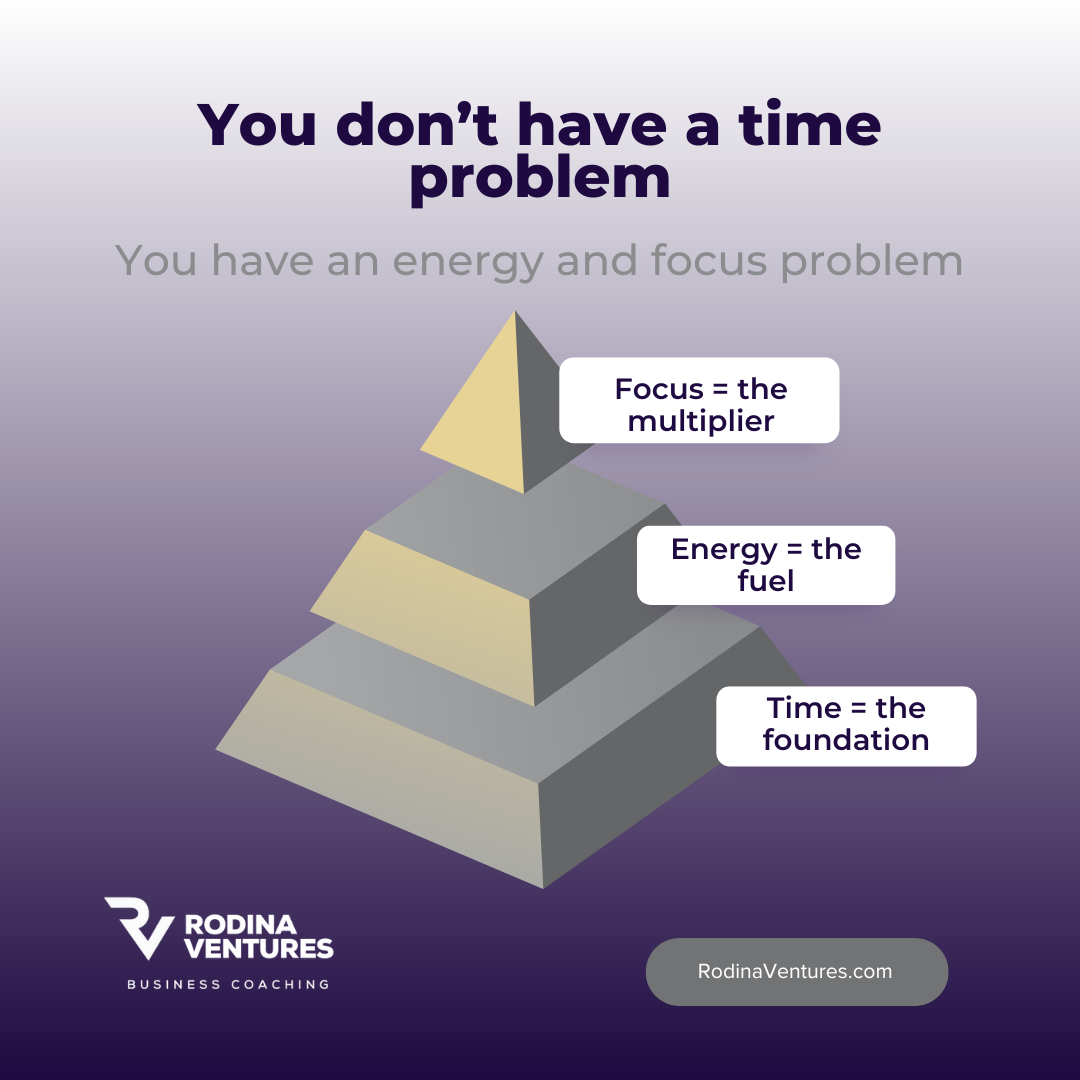The Leadership Hierarchy of Needs
Why Time Isn’t Enough
Everyone says time is the most valuable resource. You hear it in every boardroom and every leadership podcast. But here’s what I see too often: executives with plenty of meetings booked into their calendars and still nothing real to show for it.
Time is just the starting point. Without two other assets, energy and focus, your time means very little.
I’m proposing a new hierarchy of needs for leaders. At the base is time, because nothing happens without it. In the middle sits energy, the fuel that makes time useful. And at the top sits focus, the power that turns effort into results.
Let’s dig in.
Hierarchy of Needs for Leaders
Time: The Foundation
Time gives you the capacity to act. But most leaders treat time like a bucket to be filled rather than a tool to be sharpened. What matters is not how many hours you have but how you use them.
A classic Harvard Business School study tracked how CEOs spent their time over 13 weeks. It showed that top leaders are extremely selective about how they spend those hours, and that choice is what separates the ones who move the needle from those who stay reactive (1).
You need at least three skills with time:
Boundary setting: Protecting hours from noise and distraction
Prioritization: Knowing which tasks move you forward and which are noise
Calendar ownership: You decide who gets access and when
Time is non-negotiable, but it is not enough on its own.
Energy: The Fuel
You can have all the time in the world and still be ineffective if your energy is drained. Energy is what lets you show up, think, and execute well. Without it, your calendar becomes dead real estate.
Here are a few research-backed truths:
In a review of over 80 studies, Harvard Business Review authors confirmed that taking short, periodic breaks boosts performance and well-being (2).
A meta-analysis from a Romanian team found that micro-breaks (10 minutes or less) reduce fatigue and restore performance on cognitively demanding tasks (3).
A group of Wachovia employees who participated in an energy management program outperformed others in loan generation and reported higher satisfaction (4).
In short, energy is renewable if you guard it. That means sleep, recovery, mental rest, emotional health, and boundaries around work.
When leaders ignore energy, they default to brute force. That leads to burnout, low output, and decisions made in fog.
Focus: The Multiplier
This is where everything pays off. Focus turns energy and time into actual change.
In a world of distractions, few have the discipline to protect deep work. But the leaders who do can magnify impact.
Some relevant insights:
Interruption science shows that knowledge workers often switch tasks every few minutes, and after an interruption, it can take up to 30 minutes to regain full focus (5).
Research in productivity and wellness shows that strategic breaks are not luxuries; they help maintain focus across the day (6).
Some studies note that working for about 52 minutes followed by a 17-minute break can lead to higher productivity than continuous work because you preserve focus and energy (7).
Focus is not about willpower. It is about designing your time and energy so that deep work becomes your default state.
In my FOCUS™ coaching program, I help leaders structure their days, defend their attention, and align their actions to what matters most. That is how growth happens.
The Takeaway
If you want to grow as a leader and build a company worth a damn, stop aiming to “manage time.” Start investing in energy. Then protect focus. Because when those three line up, you become unstoppable.
This is exactly the kind of clarity I help leaders build in my FOCUS™ coaching program — turning intention into action, time into impact. You can learn more at RodinaVentures.com.
References
Porter, M., & Nohria, N. (2018). How CEOs Manage Time. Harvard Business Review. Retrieved from https://hbr.org/2018/07/how-ceos-manage-time
Fritz, C., & Crain, T. (2023). How to Take Better Breaks at Work, According to Research. Harvard Business Review. Retrieved from https://hbr.org/2023/05/how-to-take-better-breaks-at-work-according-to-research
Korpela, M., & Iliescu, D. (2020). Do Regular Breaks Reduce Fatigue? University of Waterloo Engineering Wellness Program. Retrieved from https://uwaterloo.ca/engineering-wellness-program/blog/spotlight-research-do-regular-breaks-really-reduce-fatigue
Schwartz, T., & McCarthy, C. (2007). Manage Your Energy, Not Your Time. Harvard Business Review. Retrieved from https://hbr.org/2007/10/manage-your-energy-not-your-time
Wikipedia. (2024). Interruption Science. Retrieved from https://en.wikipedia.org/wiki/Interruption_science
HBR Editors. (2025). A Guide to Taking Better Breaks at Work. Harvard Business Review. Retrieved from https://hbr.org/2025/02/a-guide-to-taking-better-breaks-at-work
Wealth Wise Report. (2024). Why Executives Should Focus on Energy Management Over Time Management. Retrieved from https://wealthwisereport.com/energy/why-executives-should-focus-on-energy-management-over-time-management

